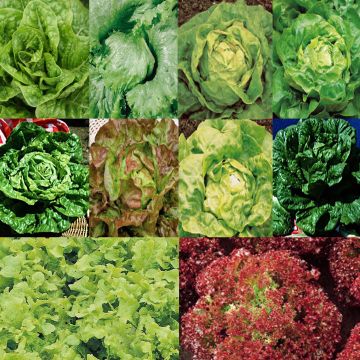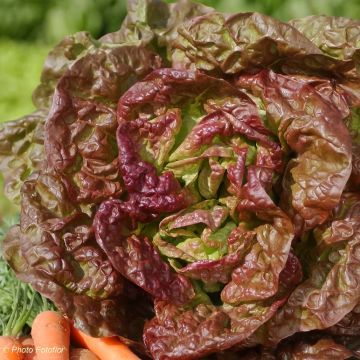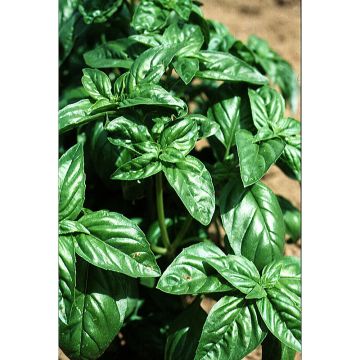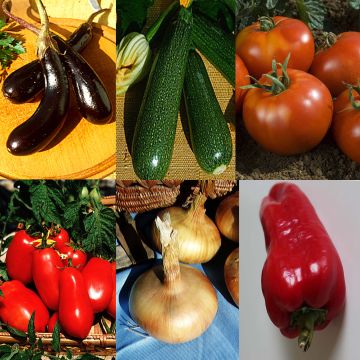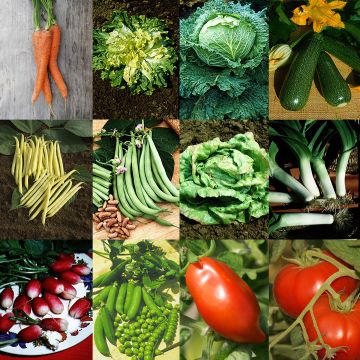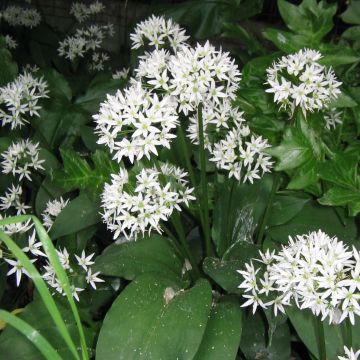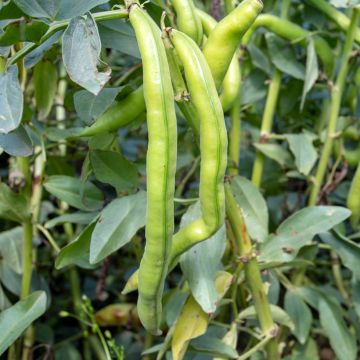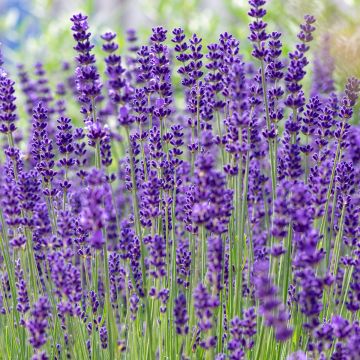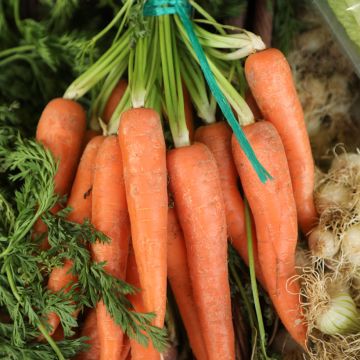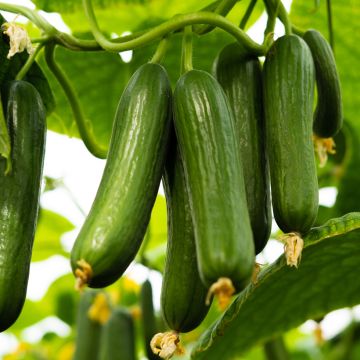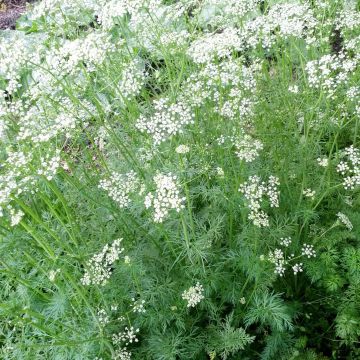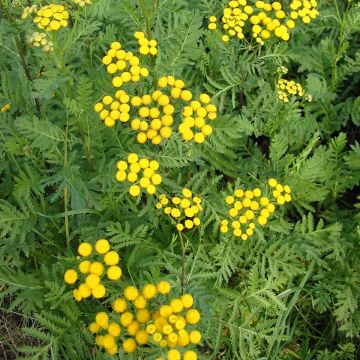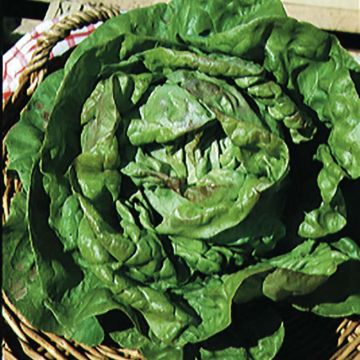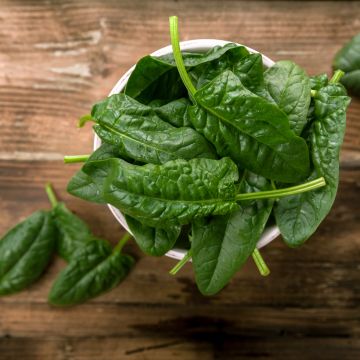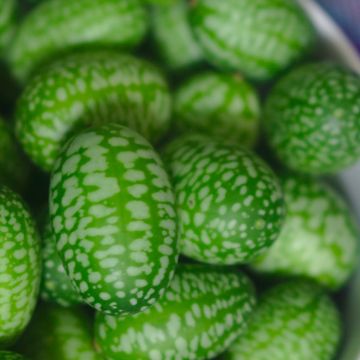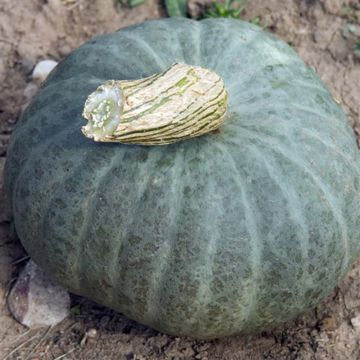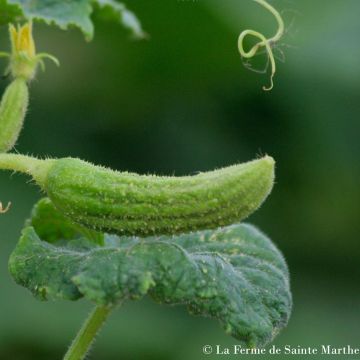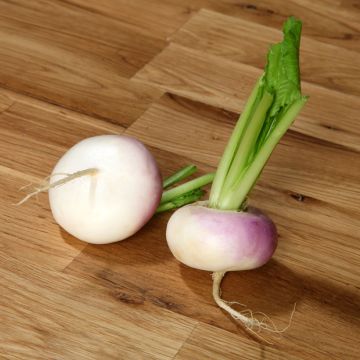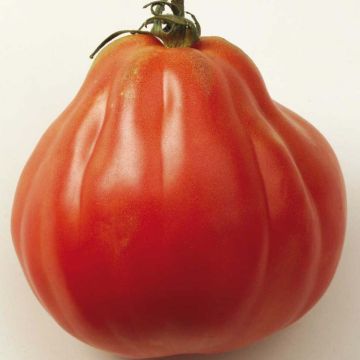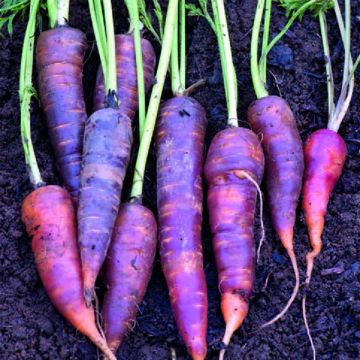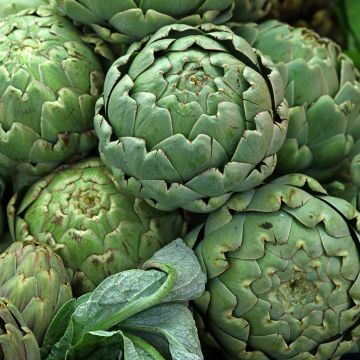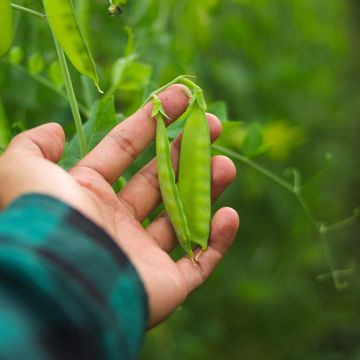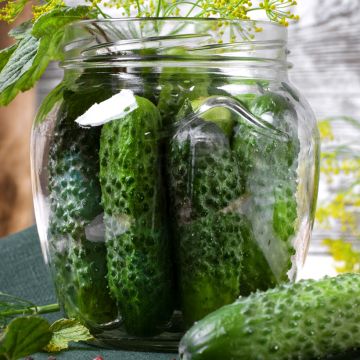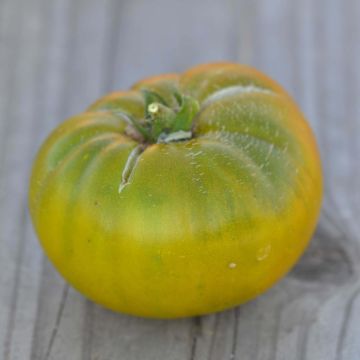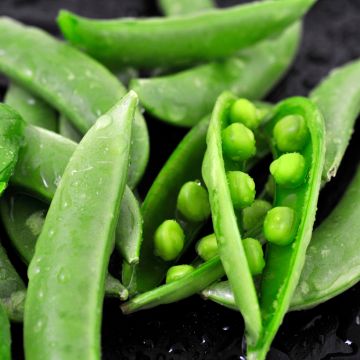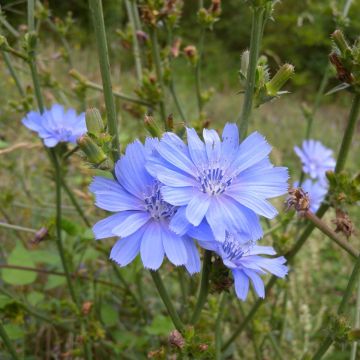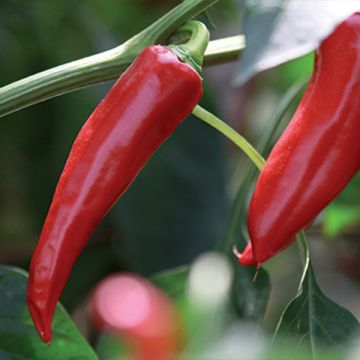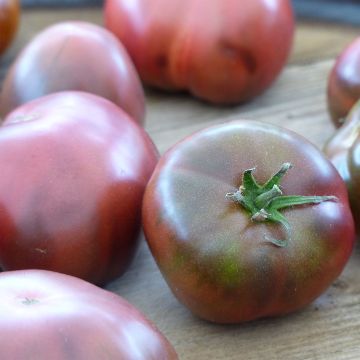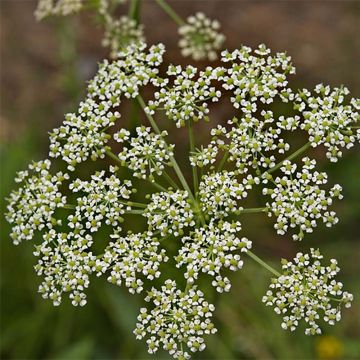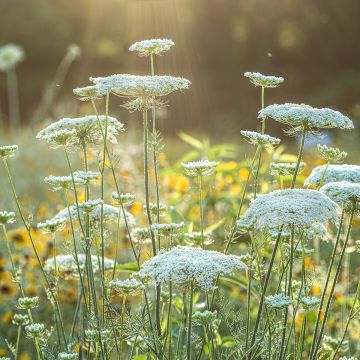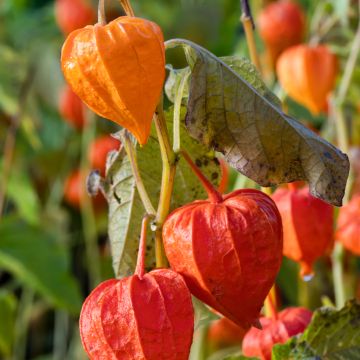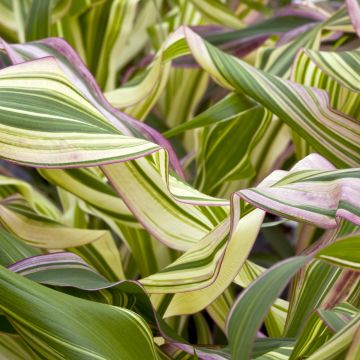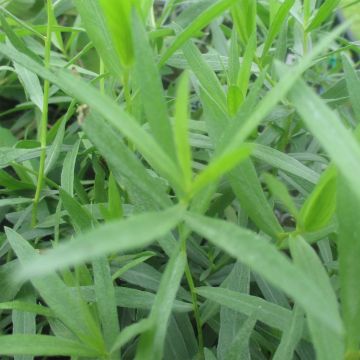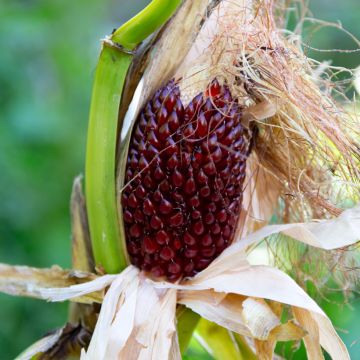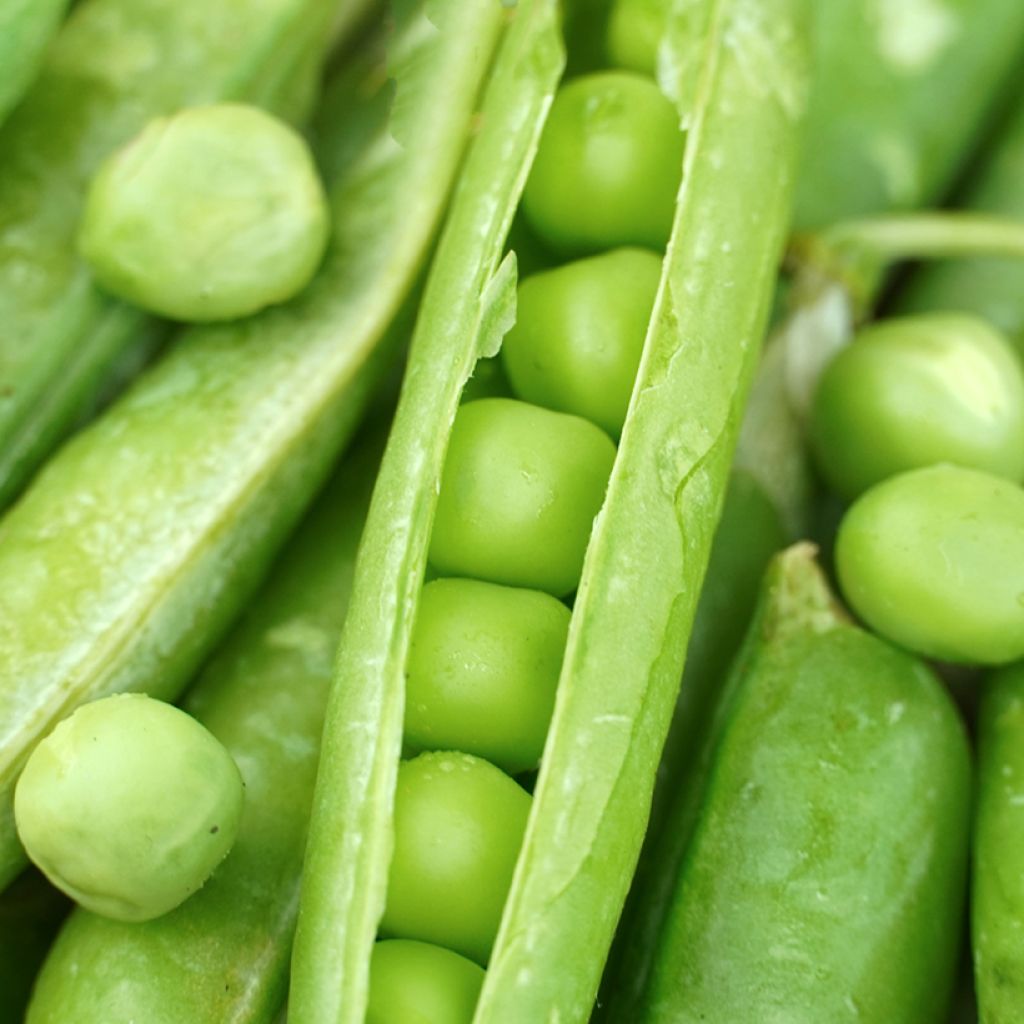

Jaguar Dwarf Pea
Jaguar Dwarf Pea
Pisum sativum Jaguar
Garden pea, Green pea, English pea
moderately pleased
Violette C., 16/08/2018
Why not try an alternative variety in stock?
View all →This plant carries a 6 months recovery warranty
More information
We guarantee the quality of our plants for a full growing cycle, and will replace at our expense any plant that fails to recover under normal climatic and planting conditions.
Seed-only orders are dispatched by sealed envelope. The delivery charge for seed-only orders is €3.90.

Description
The Jaguar Pea (Pisum sativum in Latin) is an early variety with rapid growth that produces pods, grouped in pairs and containing 8 to 9 peas. It is a vigorous pea variety that is resistant to diseases and can be sown for a very long harvest. It is sown from March to June for a harvest from June to September.
The Pea is an annual vegetable plant belonging to the Fabaceae family (formerly Leguminosae) with an ancient origin in the Near East. It is one of the oldest vegetables cultivated in Europe and Asia. It was traditionally consumed dried and crushed before cooking, and its fresh consumption is relatively recent.
There are many varieties of peas: dwarf or climbing (with stakes) varieties that produce pods filled with smooth or wrinkled round grains. They are cooked after being shelled because the parchment-like pod in which they are enclosed is not edible. Only snow peas (with flat, crunchy, and buttery pods) are consumed in their entirety.
In general, climbing peas are more productive, but they are less early and require the installation of a structure of 1.5 to 2 metres (5 to 7 feet) for them to climb. Their harvest is easy. Dwarf or semi-dwarf peas only need a few canes or sticks (from 50cm (20in) to 1 metre (3 feet)) as support. Some recent varieties, with foliage largely replaced by tendrils, can support themselves, and the use of stakes is then optional.
Smooth-grained peas are resistant to spring cold. They are very early or early varieties that can be sown very early under cover, but they do not tolerate excessive heat.
For late spring and early summer sowings, wrinkled-grained varieties with a sweeter flavour are used. They tolerate heat and offer longer harvests.
Peas are highly appreciated as a spring vegetable, but with careful selection of varieties, they can be harvested over a long period from June to September.
In cooking, peas can be consumed raw, but they are traditionally cooked to accompany meat and fish or used in the preparation of delicious soups. They are quite calorific as they are rich in carbohydrates, and they contain a lot of fibre, iron, and vitamins C and B9.
Peas like mild and humid climates but are sensitive to extreme weather conditions such as high temperatures, frost, and excessive or insufficient water, which weaken them and make them susceptible to powdery mildew and the pea moth, a small caterpillar that eats the seeds.
Harvest: Depending on the variety, peas can be harvested between two and a half and four months after sowing. Harvesting should be regular and done when the pods feel full when pressed with a finger. Don't wait too long... peas tend to harden as they age!
Storage: Fresh peas can be stored, unshelled, in the vegetable drawer of the refrigerator. They freeze very well once blanched in boiling water.
Gardener's tip: Peas, like all legumes, can fix atmospheric nitrogen in the soil, acting as green manure. This nitrogen supply is beneficial both to plants growing nearby and to those that will be planted subsequently in a crop rotation system.
Report an error about the product description
Harvest
Plant habit
Foliage
Botanical data
Pisum
sativum
Jaguar
Fabaceae
Garden pea, Green pea, English pea
Cultivar or hybrid
Annual
Other Vegetable seeds from A to Z
Planting and care
Sowing:
The germination temperature for Peas ranges from 5 to 24°C, and germination generally takes between 6 and 15 days.
Sowing period: from March to June
Harvest period: from June to September
Sowing is done directly in place, in the sun, in lightly amended and loosened soil. Create furrows that are 5cm (2in) deep, with a distance of 75cm (30in) between rows. Sow the seeds every 5cm (2in). Water and keep the soil moist until germination.
Cultivation:
Once the plants reach a height of 15cm (6in), it is necessary to mound soil around their bases and install supports, the height of which will vary depending on the variety: 0.5 to 1 metre (2 to 3 feet) for dwarf Peas and 1.5 to 2 metres (5 to 7 feet) for climbing Peas. Branches from hazel or chestnut trees work well, but you can also use pieces of wire mesh or nets sold for this purpose.
Peas are not heavy feeders and only require light fertilisation. Additional fertilisers are therefore optional and depend on the initial fertility of your soil.
Seedlings
Care
Intended location
-
, onOrder confirmed
Reply from on Promesse de fleurs
Vegetable seeds
Haven't found what you were looking for?
Hardiness is the lowest winter temperature a plant can endure without suffering serious damage or even dying. However, hardiness is affected by location (a sheltered area, such as a patio), protection (winter cover) and soil type (hardiness is improved by well-drained soil).

Photo Sharing Terms & Conditions
In order to encourage gardeners to interact and share their experiences, Promesse de fleurs offers various media enabling content to be uploaded onto its Site - in particular via the ‘Photo sharing’ module.
The User agrees to refrain from:
- Posting any content that is illegal, prejudicial, insulting, racist, inciteful to hatred, revisionist, contrary to public decency, that infringes on privacy or on the privacy rights of third parties, in particular the publicity rights of persons and goods, intellectual property rights, or the right to privacy.
- Submitting content on behalf of a third party;
- Impersonate the identity of a third party and/or publish any personal information about a third party;
In general, the User undertakes to refrain from any unethical behaviour.
All Content (in particular text, comments, files, images, photos, videos, creative works, etc.), which may be subject to property or intellectual property rights, image or other private rights, shall remain the property of the User, subject to the limited rights granted by the terms of the licence granted by Promesse de fleurs as stated below. Users are at liberty to publish or not to publish such Content on the Site, notably via the ‘Photo Sharing’ facility, and accept that this Content shall be made public and freely accessible, notably on the Internet.
Users further acknowledge, undertake to have ,and guarantee that they hold all necessary rights and permissions to publish such material on the Site, in particular with regard to the legislation in force pertaining to any privacy, property, intellectual property, image, or contractual rights, or rights of any other nature. By publishing such Content on the Site, Users acknowledge accepting full liability as publishers of the Content within the meaning of the law, and grant Promesse de fleurs, free of charge, an inclusive, worldwide licence for the said Content for the entire duration of its publication, including all reproduction, representation, up/downloading, displaying, performing, transmission, and storage rights.
Users also grant permission for their name to be linked to the Content and accept that this link may not always be made available.
By engaging in posting material, Users consent to their Content becoming automatically accessible on the Internet, in particular on other sites and/or blogs and/or web pages of the Promesse de fleurs site, including in particular social pages and the Promesse de fleurs catalogue.
Users may secure the removal of entrusted content free of charge by issuing a simple request via our contact form.
The flowering period indicated on our website applies to countries and regions located in USDA zone 8 (France, the United Kingdom, Ireland, the Netherlands, etc.)
It will vary according to where you live:
- In zones 9 to 10 (Italy, Spain, Greece, etc.), flowering will occur about 2 to 4 weeks earlier.
- In zones 6 to 7 (Germany, Poland, Slovenia, and lower mountainous regions), flowering will be delayed by 2 to 3 weeks.
- In zone 5 (Central Europe, Scandinavia), blooming will be delayed by 3 to 5 weeks.
In temperate climates, pruning of spring-flowering shrubs (forsythia, spireas, etc.) should be done just after flowering.
Pruning of summer-flowering shrubs (Indian Lilac, Perovskia, etc.) can be done in winter or spring.
In cold regions as well as with frost-sensitive plants, avoid pruning too early when severe frosts may still occur.
The planting period indicated on our website applies to countries and regions located in USDA zone 8 (France, United Kingdom, Ireland, Netherlands).
It will vary according to where you live:
- In Mediterranean zones (Marseille, Madrid, Milan, etc.), autumn and winter are the best planting periods.
- In continental zones (Strasbourg, Munich, Vienna, etc.), delay planting by 2 to 3 weeks in spring and bring it forward by 2 to 4 weeks in autumn.
- In mountainous regions (the Alps, Pyrenees, Carpathians, etc.), it is best to plant in late spring (May-June) or late summer (August-September).
The harvesting period indicated on our website applies to countries and regions in USDA zone 8 (France, England, Ireland, the Netherlands).
In colder areas (Scandinavia, Poland, Austria...) fruit and vegetable harvests are likely to be delayed by 3-4 weeks.
In warmer areas (Italy, Spain, Greece, etc.), harvesting will probably take place earlier, depending on weather conditions.
The sowing periods indicated on our website apply to countries and regions within USDA Zone 8 (France, UK, Ireland, Netherlands).
In colder areas (Scandinavia, Poland, Austria...), delay any outdoor sowing by 3-4 weeks, or sow under glass.
In warmer climes (Italy, Spain, Greece, etc.), bring outdoor sowing forward by a few weeks.

































